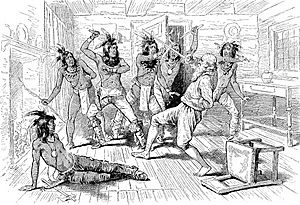Raid on Dover facts for kids
Quick facts for kids Raid on Dover |
|||||||
|---|---|---|---|---|---|---|---|
| Part of King William's War | |||||||
 Major Waldron defending garrison |
|||||||
|
|||||||
| Belligerents | |||||||
| New France Abenaki (Pennacook and Maliseet) |
New England Colonies | ||||||
| Commanders and leaders | |||||||
| St. Castin; Father Louis-Pierre Thury; Kancamagus (also known as John Hogkin or Hawkins) | Major Richard Waldron | ||||||
| Strength | |||||||
| Unknown | Unknown | ||||||
| Casualties and losses | |||||||
| Unknown | 23 killed, 29 captured | ||||||
The Raid on Dover, also called the Cochecho Massacre, was a big event in Dover, New Hampshire. It happened on June 27–28, 1689. This attack, led by Chief Kancamagus, helped start King William's War. This war involved many attacks planned by Jean-Vincent d'Abbadie de Saint-Castin and Father Louis-Pierre Thury.
Contents
Why the Raid Happened
A Past Conflict
At the end of King Philip's War (1675-1678), many Native Americans were running from the Massachusetts Bay Colony army. They found safety with the Abenaki tribe in Dover. The army told Major Richard Waldron to attack these natives. They wanted him to hand over the fighters who were seeking safety.
A Tricky Plan
Major Waldron thought he could capture them without a real fight. So, on September 7, 1676, he invited about 400 natives to a fake battle. Half of these natives were local, and half were those seeking safety. The mock battle happened near Cochecho Falls. After the natives fired their guns, Waldron and Major Charles Frost took them prisoner.
The Aftermath of the Deception
Waldron sent the captured fighters and those who fought back to Boston. There, about seven or eight were found guilty of rebellion and executed. The rest were forced to work for others far away, mostly in Barbados. The local natives were set free. However, they never forgot Waldron's trick. They felt he had broken rules of honor and kindness. Waldron became the main judge for New Hampshire in 1683.
The Attack and Revenge

A Surprise Attack
Thirteen years went by, and the settlers thought the old event was forgotten. Then, members of the new Wabanaki Confederacy arrived in Dover. Citizens told Waldron they were worried. But he told them to "go and plant your pumpkins," saying he would handle the natives.
The Night of the Raid
On June 27, 1689, two native women came to each of five fortified houses, called garrison houses. They asked to sleep by the fire, which was common in peaceful times. All but one house said yes. In the dark early hours of the next day, the women opened the doors. This allowed warriors, who had been hiding, to enter.
Waldron's Fate
The elderly Waldron, who had a sword, was cut across his stomach with knives. Each warrior said, "I cross out my account." Five or six homes were burned, along with the mills. Fifty-two colonists, which was a quarter of everyone living there, were either captured or killed.
What Happened Next
Captives Taken
Among those captured was Sarah Gerrish, Waldron's seven-year-old grandchild. She was the daughter of Elizabeth and John Gerrish. These were the first British captives recorded to be taken by natives and sold in Quebec.
Other Attacks
The next month, Pemaquid, Maine, faced a similar attack. John Gyles was taken prisoner at Pemaquid. He was brought back to Dover. There, he said he was with other captives from the earlier Dover raid.
Lasting Impact
The William Damm Garrison House was built in 1675. It survived the raid. Later, it was moved to the Woodman Institute Museum. This house is now listed on the National Register of Historic Places.

